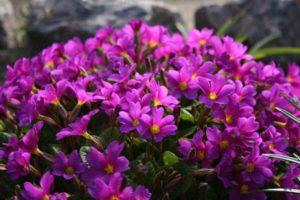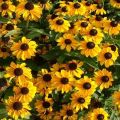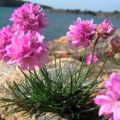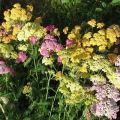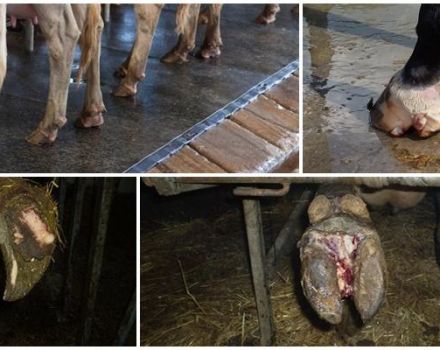Planting and caring for badan in the open field, description of varieties and species
The amazing decorative properties of badan make it one of the most popular cultures for creating magnificent landscapes in gardens, public areas that can decorate any landscape design. To enjoy from early spring to late autumn the mesmerizing appearance of berry, you need to familiarize yourself with all the nuances of proper planting and caring for a plant in the open field.
Content
- 1 Features and characteristics of badan
- 2 Popular species and varieties
- 3 Application in landscape design
- 4 Necessary conditions for growth and flowering
- 5 Germinating a plant from a seed
- 6 The nuances of growing incense by cuttings
- 7 How to care for a plant outdoors
- 8 How and when the seeds are harvested
- 9 Culture propagation methods
- 10 Growing and care problems
Features and characteristics of badan
Badan refers to perennials that are capable of growing for 10 years without transplanting in one place. A plant with a thick rhizome close to the surface of the ground and massive basal round leaves. Shiny foliage retains its decorative effect throughout the growing season.
Thanks to pink, white, lilac flowers, collected at the top of low stems in dense racemose inflorescences, the culture is especially popular with gardeners. Flowering occurs in May and lasts up to 20 days. After its completion, the plant remains decorative, as it forms a dense cover 15-20 cm in height.
Popular species and varieties
Gardeners cultivate 10 types of bergenia, but the following are considered popular:
- Badan is thick-leaved. Perennial reaching up to 60 cm in height. The bushes have large leathery leaves painted in a bright green color, which changes to fiery red in autumn. Bell-shaped flowers of white, lilac, purple shades attract attention. The species boasts varieties:
- Purpurea;
- Giderruspe;
- Senor.
- Badan is hearty. The bushes, growing up to 60 cm in height, have dense, heart-shaped leaves, and flowers lilac with a pink tint. Many varieties have been bred on the basis of this species:
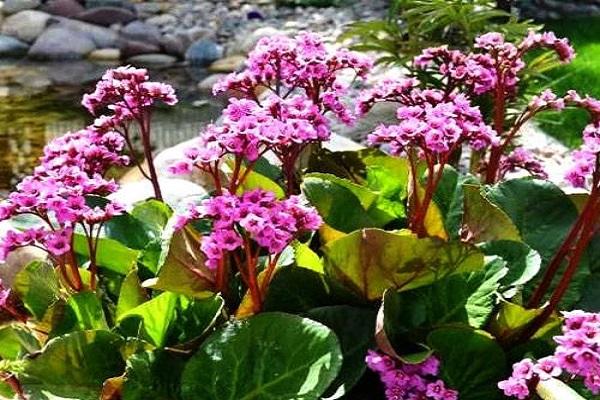
- Baby Doll;
- David
- Badan Strechi. The plant is valued for its ovoid, serrated at the edges of the leaves and large white, pink flowers with a lilac shade, collected in a brush.
- Badan Hissar. Perennial is characterized by elongated large foliage and white flowers, collected in a one-sided racemose inflorescence. Among the famous varieties:
- Alba;
- Beethoven;
- Gazebo.
- Badan is ciliated. This species is distinguished by the presence of cilia or nap at the base of the leaves. Light pink or white flowers with a bright, almost purple calyx attract attention.
- Badan purple. One of the spectacular plant species that has shiny leaves and crimson flowers.
- Badan pacific. A very large flower up to 50 cm in height, decorated with a peduncle of red color with pink flowers resembling small bells in appearance. Due to its tough dark green leaves, it is in particular demand among gardeners.
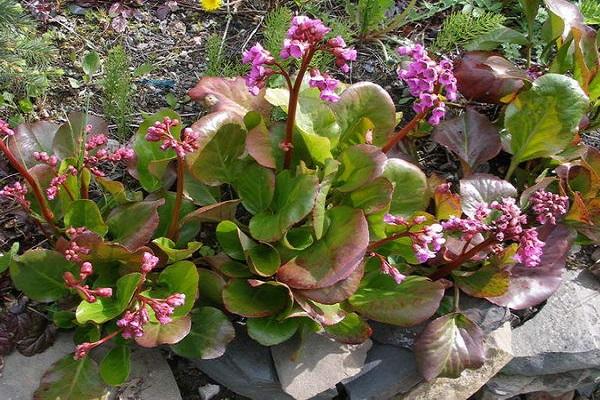
Application in landscape design
Badan will definitely become one of the colorful decorations of the garden plot. With its grace and luxury, it will make the territory of the garden stylish and original, preserving its beautiful appearance until late autumn.
Necessary conditions for growth and flowering
The main secret of success in growing bergenia is the creation of optimal environmental conditions, similar to its natural.
Illumination
Badan belongs to shade-tolerant crops, so it is not necessary to place it in open sunny areas. When choosing a place for planting, it should be borne in mind that in partial shade, where the soil keeps moisture for a long time, the berry grows with a green carpet, but will not please with spectacular flowering. Having planted a perennial in the sun, you can enjoy a beautiful flowering, but in this case, the flower will not form a beautiful lush carpet of foliage.
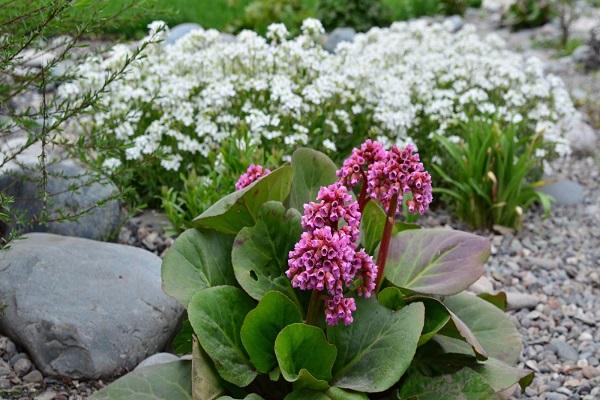
Required soil composition
Badan requires high-quality drainage, no stagnant water, and slightly acidic or neutral soil. If there is poor soil for planting, you need to prepare a mixture containing sand, fine gravel, turf soil. Take all components in the same amount.
Humidity and temperature
In a garden, make sure that the flower is moist and not overdried. Overflow or stagnation of water must not be allowed. This is detrimental to badan. Perennial does not need to be sprayed and constantly moistened, as it is characterized by drought resistance.
Badan is a frost-resistant plant, so it is not afraid of low temperatures.
The right and the wrong neighborhood
Badan, planted next to a fern, juniper, astilbe, lungwort, creates original compositions on flower beds. An unsuitable neighborhood is observed with lilies of the valley, periwinkle and the rest of the low-growing and creeping crops, since the badan prevents their growth. A perennial looks harmoniously next to deciduous trees. It is also beautiful surrounded by spring flowers such as hyacinths, snowdrops, woods, crocuses.
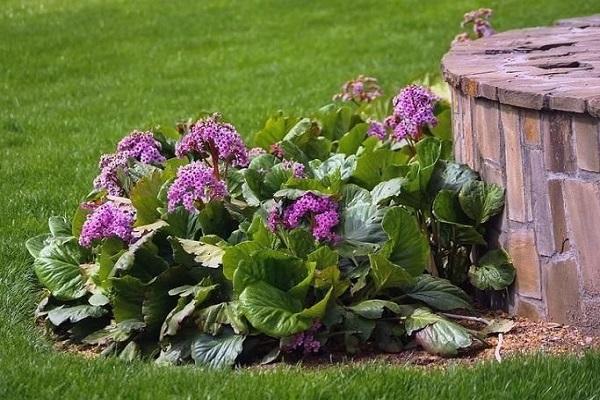
Germinating a plant from a seed
It is easy to grow a full-fledged plant from a seed, but it is a long process. There are two ways: soil - in autumn and seedling - in early spring.
Choosing a landing site
When choosing a place, give preference to areas with natural drainage so that there is no stagnation of water. Add sand or fine gravel to the soil.
The timing and technology of sowing a flower
Before you start planting badan, you need to know not only the technology of planting a flower, but also correctly determine the timing of when to plant a crop.
In the spring
Experienced gardeners point out that it is better to plant an incense in early spring. To do this, in early March, fill the container with soil substrate and make the grooves 5 mm deep. Water the holes and sprinkle the seeds, close them up. Move the container with crops to the street and place under the snow. In early April, bring to a warm room. In the middle of summer, plant seedlings in a flower bed.
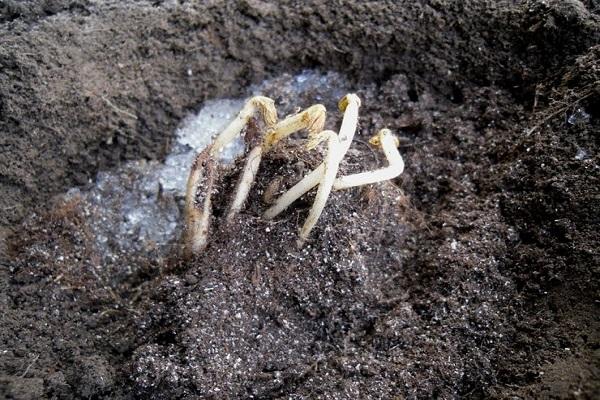
Autumn before winter
You can sow incense before winter. In September, bury the seeds directly into the soil and water constantly. With the onset of cold weather, cover the seedlings by applying fallen leaves, straw, and leave for the winter.
Seedling care
Follow-up care for seedlings includes activities such as:
- moistening the soil as its top layer dries up;
- loosening;
- providing room ventilation;
- thinning of sprouts.
Important! When a green crust or plaque forms on the soil surface, the soil should be carefully loosened, this phenomenon signals that oxygen is not supplied to the roots of the sprouts. It can be caused by over-watering.
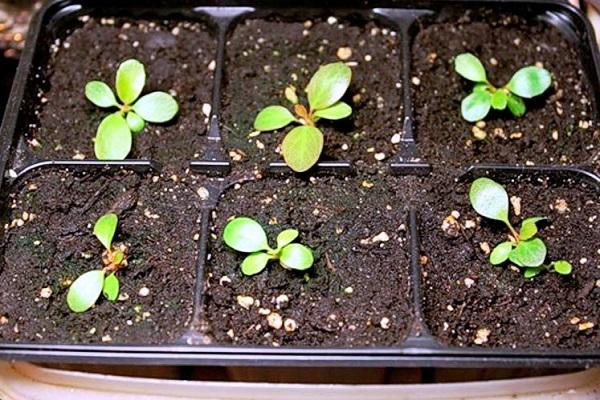
Picking
In May, seedlings need to dive. To do this, take a large box and plant the sprouts, keeping the distance between them 5-7 cm, and between the rows - 15 cm. 2 weeks before planting in the flower bed, start hardening, taking them out into the fresh air every day, gradually increasing the duration of the session. Once the seedlings have been outdoors for 24 hours, they can be planted in open soil. The landing time depends on the climate of the region. Better to wait out the night frosts than to ruin the seedlings.
The nuances of growing incense by cuttings
Cutting involves the selection of large berry bushes at the age of 6 years. Plant the cuttings in loose soil, deepening the rosettes. The root should be at a depth of 5 cm. One bush is capable of producing 10 to 20 new plants. No need to wait for active adaptation of cuttings. Usually they do not form rosettes for about 3 years, but bloom 2-3 years after planting.
How to care for a plant outdoors
Competent care will give the unpretentious berry even greater aesthetics. It is important to carry out all agrotechnical techniques correctly.
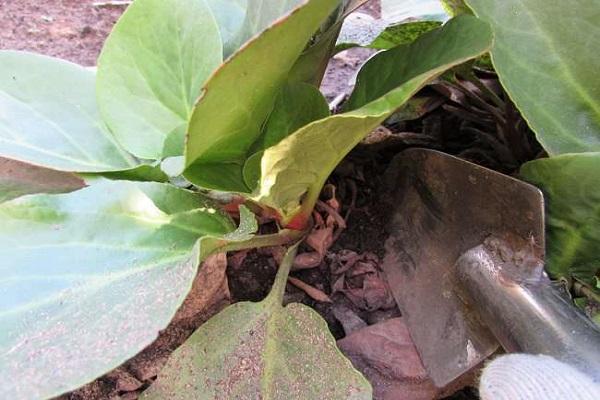
How often to water?
One of the important care measures is high-quality watering. Badan needs abundant irrigation at the time of budding and flowering. In the future, water only in the complete absence of precipitation. In rainy weather, irrigation should be avoided.
Fertilizing and loosening the soil
Badan is responsive to well-chosen feeding. The crop must be fertilized before and after flowering using mineral fertilizers. This will help stimulate further growth of the perennial. To restore reserves of nutrients and accelerate the growth of rosettes, the bushes after the wilting of the inflorescences need to be fed again.
Formation of bushes
Many gardeners are interested in whether it is necessary to cut the berry. The formation of the bushes is carried out in early spring and includes:
- checking the integrity of the roots and the presence of growth buds;
- cleaning from dry leaves, last year's inflorescences;
- trimming excess shoots, while leaving only independent bushes.
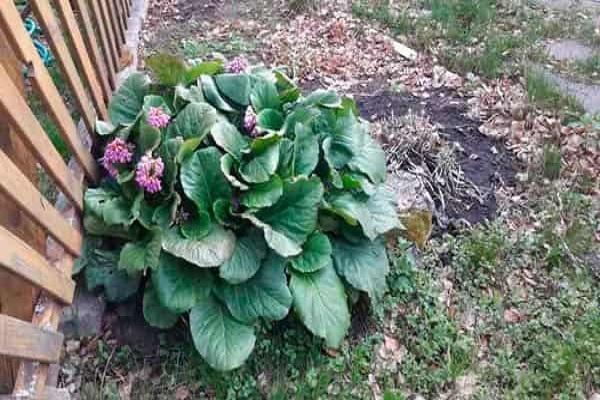
Pest and disease control
Diseases overwhelm badan with a lack of attention. Healthy bushes are resistant to diseases and pests. Fungus and decay of the root system can be dangerous. These problems arise due to the increased moisture in the soil. Control measures include pruning and burning the affected parts.
Of the pests that perennials can choose, weevils are insidious. The beetles themselves are not as dangerous as their larvae, which feed on the roots of the flower. To combat it, you need to use special chemicals. And in order to prevent it in the spring, remove all the darkened foliage, since weevils winter under it.
Perennials can also be attacked by slugs, nematodes and slobbering pennies. Dig up the bushes affected by them and destroy them to prevent spreading, and treat the flower bed where they grew with insecticides.
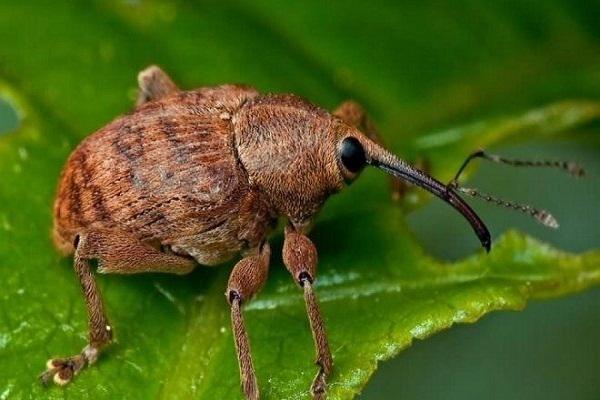
Transfer
Badan reacts negatively to frequent transplants. The perennial grows strongly and shows aggression, seizing the territory intended for other crops, therefore, it requires transplanting to new places every 6 years. To do this, in September, transplant a flower using the method of dividing the bush. Plant parts of the plant, keeping a distance between them of at least 30 cm.It should be borne in mind that with frequent transplants, the plant will not have time to recover, it will look depressed and often hurt.
Important! The uncontrolled spread of the plantings will provoke their excessive density, which leads to the appearance of diseases and the invasion of insects.
Preparation and wintering of garden badan
A change in the color of badan leaves is a signal of the first frost. This phenomenon indicates that the plant began to accumulate sugar in the tissues, which will provide the bushes with a favorable wintering. For each type of culture, the leaves turn red in different ways - in some, a yellow border forms along the edge of the leaf plate, which becomes saturated with cold weather, in others a colorful ornament of streaks spreads along the leaf, in others the foliage immediately acquires a crimson color.
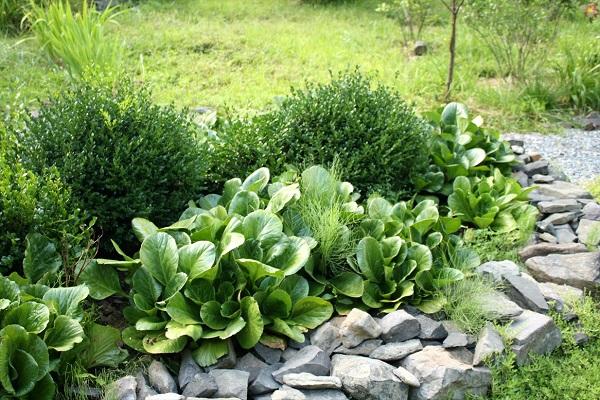
Due to the huge supply of sugar, cold winters are not terrible for perennials. The main condition is not to cut off its wilted leaves in the autumn, as they will serve as a natural protection from the cold. It is important to prepare young plants for winter by covering them with spruce branches.
How and when the seeds are harvested
The seed collection period is in September. The ability of bergenia to form a large number of seeds saves the gardener from problems with planting material. In advance, you need to outline a brush with large flowers, and with the onset of wilting, tie the inflorescence into a bag of gauze. Cut off the ripe box and dry it by sending it to a warm room for 2 weeks. Then clean, pack in paper bags and store.
Culture propagation methods
The culture can be propagated by the seed method, by cuttings.
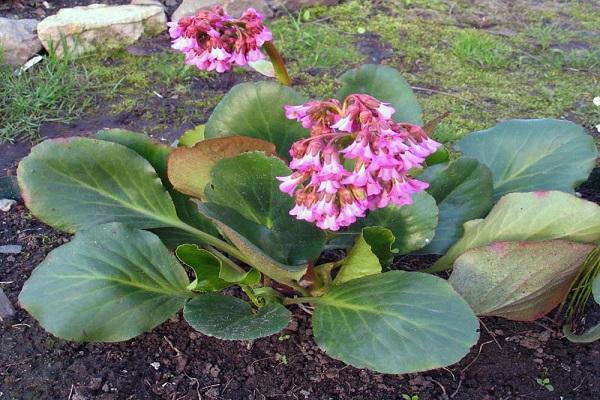
Seeds
Badan can be propagated by seeds, but this method is considered to be long-lasting and requires a lot of attention from gardeners. The seedling turns out to be small and blooms 2 years after planting. And before that, it pleases with intricate leaves and fills the garden with the freshness of a summer day.
Cuttings
To breed perennials by cuttings, you need to select healthy plants. Before planting, separate the part of the branch, which should have an apical bud and a rosette. Then, having cut off the foliage, plant the prepared cuttings at a distance of 40 cm from each other, deepening the rosette into the soil substrate to the base.
You can also propagate by dividing the bush. To do this, in early September or early March, dig out a large bush, divide it into 4 parts and plant, keeping a distance of 40 cm between them.For this method, it is important to use a bush that is more than 5 years old, a young plant will not survive division well, eventually it will start get sick and die.
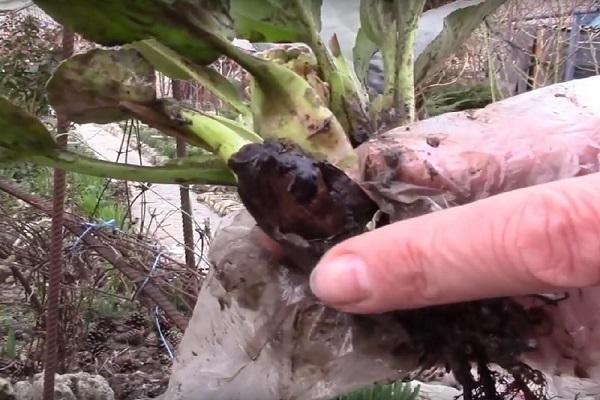
Growing and care problems
When breeding bergenia, gardeners are faced with many problems, the main of which are the lack of growth and flowering of the culture.
Does not grow
If bergenia leaves do not grow, you need to organize high-quality drainage, and also make sure that there is no stagnant water. Another reason for stopping growth can be the appearance of diseases and pests. An unsuitable neighborhood of plants in flower beds can also negatively affect growth.
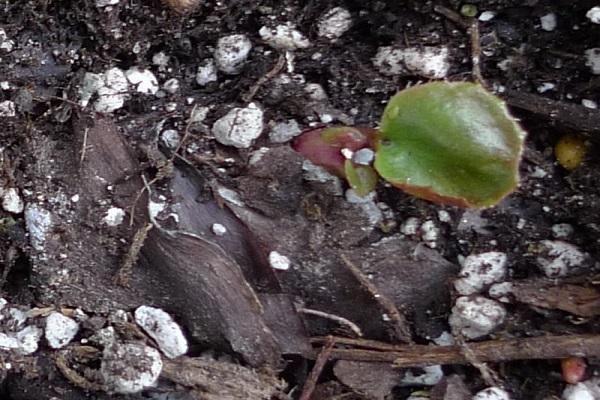
Does not bloom
If badan does not please with its flowering, it means that the site for planting has been chosen incorrectly. For this, it should be borne in mind that the plant in direct sunlight or in the shade will not form inflorescences. Also, dense plantings or fungal infections may be the cause.
This beautiful herbaceous perennial surprises with its simplicity, expressive appearance and versatility in use. All these positive aspects make badan a welcome guest in any garden.
